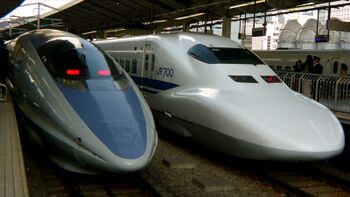Bullet train (Japan)
The bullet train, officially the Shinkansen (新幹線) is Japan's fastest train, with a network stretching from northern Aomori in Honshu to Fukuoka[1] in southern Kyushu, with construction of an extra line under way to extend an unbroken link down to Kagoshima at the southern tip of the main islands. The Japanese bullet train was the world's first high-speed rail service, inaugurated in 1964 and run by Japan Railways (JR). Coming into service at the time that Tokyo hosted the 1964 Summer Olympics, the trains were used to carry spectators, athletes and the media to events in Osaka to showcase Japan's emergence from its post-war malaise. As of March 2010, there has never been a fatal accident, despite trains regularly reaching speeds of 180mph (300km/h) and earthquakes in the region; the trains are also notoriously punctual, with delays averaging under a minute.[2]
The network is divided into subsections, meaning that passengers travelling between the northern and southern regions of Honshu island must change at Tokyo. One of the notable services is the Nozomi (のぞみ) Super Express, which travels between Tokyo and Fukuoka, and non-stop between Yokohama and Nagoya. The Nozomi commands higher fares due to the limited number of stops.
In Kyushu, a separate bullet train service, the Tsubame (つばめ), has been operating since 2004. The trains are notable for their unusual design, with the front of the main engine resembling an animal, with sets of vertically-positioned headlights for 'eyes'. From March 2011, a new link will connect this service with the wider network, making it possible to travel the length of Honshu and Kyushu via the bullet train. Future plans include bringing the service to the northernmost main island, Hokkaido.
Travelling on the bullet train

Travelling by bullet train requires that an extra supplementary fare be paid on top of the regular fare used for slower train services. Such fees are incorporated into the total ticket price, paid when a passenger purchases a bullet train ticket either from a multilingual machine or a JR representative. Machines always take cash but may not accept cards, particularly foreign ones. Machines also reserve seats if the passenger desires.
Passengers reach the platforms by going through ticket barriers ('wickets') which require any seat reservation tickets to be inserted at the same time as the ticket itself. Bullet train services are separated from both slower JR and non-JR services, so passengers may find themselves going through several sets of barriers in order to reach their train. Platforms are marked with carriage numbers and show exactly where passengers should queue; trains will halt exactly where the platform indicates, and usually only briefly stop at each station.
Most carriages are for reserved-seat ticket holders only; usually, there are a few non-reserved carriages, which become crowded at peak times. All tickets and seat reservation receipts are inspected on board and passengers sitting in the wrong seat or carriage will often be asked to move, or face a fine. Carriages are also divided between standard class and 'green car' (first class) status, and are also designated smoking or non-smoking. Standard class carriages accommodate rows of five seats, three on one side and two on the other, all forward-facing. Luggage space is limited (Japanese travellers often make use of courier services to send bags on to their destination separately). 'Green cars' are more spacious, though there are no complimentary services. Trains are equipped with vending machines, smoking rooms, private rooms for baby-changing, etc., washbasins with mirrors, and a range of toilets including 'Japanese-style', 'Western-style', and even urinals.
Footnotes
- ↑ Fukuoka's railway station is named 'Hakata'.
- ↑ Hood (2006: 1-2).
- ↑ Japan Times: ''Dr. Yellow' train keeps line safe, elates spotters.' 11th March 2010.
